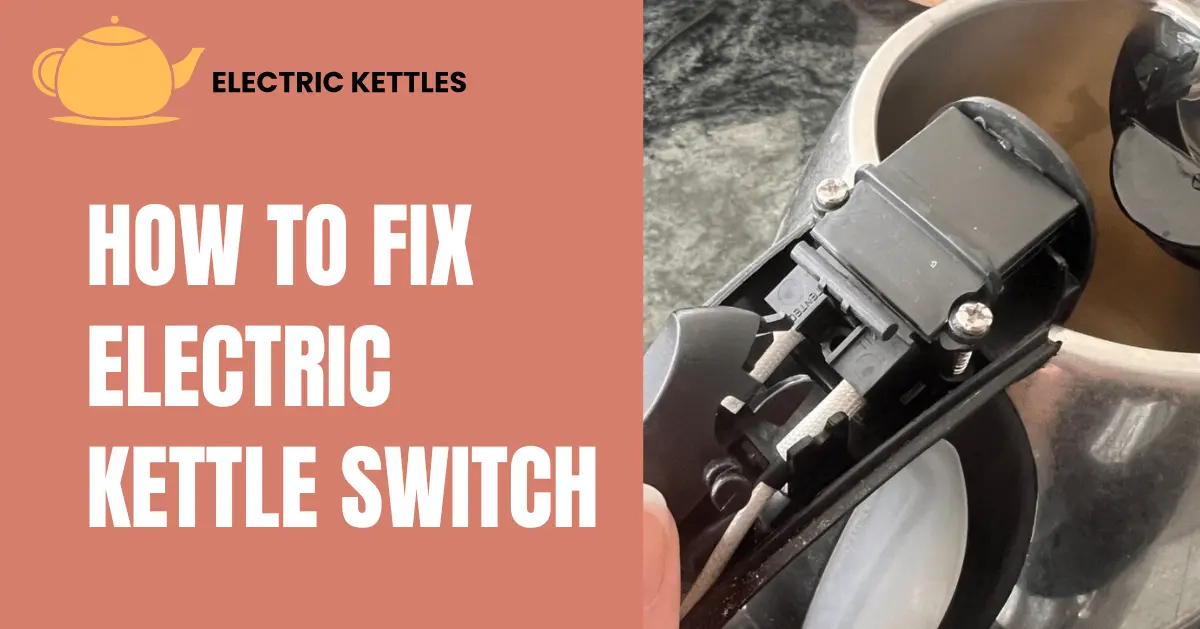How to Fix Electric Kettle Switch
Electric kettle switches can have various issues that affect their performance. A common problem is that the switch may not work at all. This could be due to a faulty internal mechanism or a broken connection. Sometimes, the switch might get stuck, causing the kettle to stay on or off unexpectedly. These problems can be frustrating, especially if you rely on your kettle for daily use.
Another issue is the wear and tear of the switch over time. Regular use can lead to the switch becoming loose or unresponsive. In some cases, water or steam may get into the switch area, causing it to malfunction. It is essential to address these problems quickly. Ignoring them can lead to more significant issues or even safety hazards.
Table of Contents
Common Signs of a Faulty Switch
Kettle Won’t Turn On
If the kettle does not power up when the switch is pressed, it may indicate a defect in the switch itself. Check if the kettle is plugged in properly. If everything seems fine and the kettle still won’t turn on, it’s likely that the switch is the culprit.
Intermittent Functionality
If the kettle turns on and off unexpectedly, this can signal a loose or damaged connection within the switch. It might work sometimes but fail at others, making it unreliable for regular use. This inconsistency can be frustrating, especially when you need hot water quickly.
Switch Sticking
If the switch feels stuck or unresponsive when pressed, this may mean it has become jammed or damaged. A sticking switch can prevent the kettle from operating correctly and may require disassembly for proper inspection and repair.
Burning Smell
A burning odor when using the kettle is a serious sign of overheating within the switch. This can occur if there is an electrical short or if the switch is malfunctioning. If you notice this smell, unplug the kettle immediately to avoid potential fire hazards.
Visible Damage
Look for cracks, breaks, or any visible damage on the switch itself. Physical damage can lead to improper functioning and is a clear indicator that the switch needs to be replaced. Even minor damage can affect the kettle’s performance significantly.
Unusual Noises
Any strange sounds, like clicking or buzzing, when the switch is activated can suggest internal problems. These noises may indicate electrical issues or component failure within the switch, which could lead to complete malfunction if not addressed.
Tools and Materials Needed
Having these tools and materials on hand will make the process of fixing the electric kettle switch more efficient.
- Screwdriver Set: A set of screwdrivers, including both Phillips and flathead types, is essential for opening the kettle’s base. Make sure to choose the right size to avoid damaging the screws.
- Multimeter: A multimeter helps check the electrical continuity of the switch. It can help diagnose whether the switch is functioning correctly or if there is an electrical fault.
- Wire Cutters/Strippers: These tools are used to cut or strip wires if you need to replace any damaged wires connected to the switch. Having these handy ensures that you can make clean cuts and connections.
- Replacement Switch: Purchase a compatible replacement switch specific to your kettle model. Check the specifications to ensure a proper fit. This part is crucial if the current switch is faulty beyond repair.
- Insulation Tape: Insulation tape is necessary for securing any exposed wires after repairs. It helps prevent electrical shorts and ensures safety during the kettle’s operation.
- Small Brush or Vacuum: A small brush or vacuum can help clean out any dust or debris from inside the kettle’s base. Keeping the area clean can prevent future issues and ensure proper function.
- Safety Gear: Wearing safety glasses and gloves is advisable when working on electrical appliances. These protect you from potential injuries while handling tools and components.
- Work Surface: A clean, flat work surface provides a safe space to lay out tools and components. This helps keep everything organized and prevents any loss of small parts during the repair.
Step-by-Step Guide to Fixing the Switch
Step 1# Unplug and Prepare the Kettle
Begin by unplugging the kettle from the power source. This is crucial for your safety. Allow the kettle to cool down if it was recently used. Gather all necessary tools and materials in a clean, flat workspace to ensure you have everything within reach.
Step 2# Open the Kettle Base
Using the screwdriver, carefully remove the screws on the kettle’s base. Keep the screws in a safe place so you don’t lose them. Once the screws are removed, gently lift off the base. Be cautious of any clips or tabs that may also need to be released to access the interior components.
Step 3# Inspect the Switch
Locate the switch inside the kettle. Check for any visible damage, such as cracks or burnt areas. Use the multimeter to test for continuity by touching the probes to the switch terminals. If there is no continuity, the switch is likely faulty and needs to be replaced.
Step 4# Replace or Repair the Switch
If the switch is damaged, carefully disconnect it by unscrewing or unclipping it from its position. If you’re replacing it, connect the new switch according to the manufacturer’s instructions, ensuring the wiring is secure. If you’re repairing the switch, clean any dirt or debris and check the internal mechanism for functionality.
Step 5# Reassemble the Kettle
Once the switch is repaired or replaced, carefully reattach the kettle base. Make sure all clips and tabs are properly aligned before securing it with screws. Double-check that everything is tightly fastened to avoid any issues when using the kettle.
Testing the Kettle After Repair
After repairing or replacing the switch, start by inspecting the kettle to ensure everything is secure. Check that all screws are tightened and that there are no loose wires. This initial inspection helps prevent any issues during the testing process.
Next, plug the kettle into a power outlet and gently press the switch to turn it on. You should hear a click or feel a response from the switch. If the switch feels stuck or unresponsive, you may need to disassemble the kettle again to address the issue.
Once the switch activates smoothly, fill the kettle with a small amount of water and place it on its base. Turn on the kettle and observe if it heats the water effectively. It should reach boiling point in a reasonable time, indicating the repair was successful.
When to Seek Professional Help
If you encounter persistent problems with the kettle switch after attempting repairs, it may be time to consult a professional. For instance, if the switch continues to malfunction or if the kettle fails to turn on even after replacing the switch, this could indicate a more serious internal issue. Experienced technicians can accurately diagnose complex problems that may not be easily visible or fixable at home.
Another reason to seek professional help is if you notice signs of electrical hazards, such as burning smells, smoke, or sparks. These indicators can suggest serious electrical issues that pose safety risks. It’s crucial to prioritize your safety; in such cases, unplug the kettle immediately and refrain from using it until a qualified technician inspects it.
Additionally, if you are not comfortable working with electrical components, it’s best to leave repairs to the professionals. Handling internal parts of an electric kettle requires knowledge and experience, and improper handling can lead to further damage or personal injury. Professionals have the right tools and expertise to ensure safe and effective repairs.
Conclusion
Fixing an electric kettle switch is a manageable task if you follow the right steps. Start by identifying the problem and gathering the necessary tools and materials. Inspecting the switch carefully is crucial, as this helps determine if you need to repair or replace it. Proper testing after the repair ensures the kettle operates safely and efficiently.
If you face persistent issues or notice any signs of electrical hazards, it’s best to seek professional help. Handling electrical components can be risky, so prioritize safety. Regular maintenance of your kettle can also prevent future problems.







